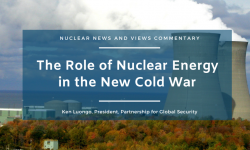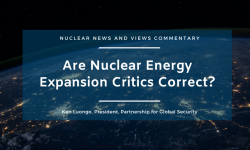The Biden administration’s new announcements to “Bolster Domestic Nuclear Energy,” are a welcome effort to create a more cohesive ecosystem to support the deployment of U.S. reactors in pursuit of decarbonization.
While it is understandable that the administration would focus on the economic and clean energy value of domestic nuclear energy in an election year, mostly left out of the announcement’s fact sheet was a plan for how to engage with nuclear exports in a more effective way.
The announcement’s focus was on “large nuclear builds” in the U.S. and at its heart is a new government-led Nuclear Power Project Management and Delivery working group.
Its mandate is identifying, “opportunities to proactively mitigate sources of cost and schedule overrun risk.” This certainly is a core challenge to building more reactors domestically or overseas. The working group plans to consult “range of stakeholders.”
The announcement also identified the litany of existing programs, regulatory reforms, and legislation designed to support this expanded nuclear ecosystem.
When taken together, the administration claimed that “these actions represent the largest sustained push to accelerate civil nuclear development in the United States in nearly five decades” and it is hard to argue with that assertion.
But while bolstering nuclear energy at home, it is important not to forget about the fight for nuclear energy market share overseas and its clean energy, energy security, and geopolitical implications.
The fact sheet did reference the U.S. Export-Import Bank and State Department's EXIM SMR Financing Toolkit that is designed to help U.S. small reactor exporters. It also noted the recently signed ban on the import of Russian enriched uranium and the nearly $3 billion made available to expand U.S. uranium enrichment capability.
Beyond these efforts, there are several other programs in the executive branch designed to support American nuclear exports, many with a particular focus on small reactors.
But the level of cohesion and energy that the administration is trying to bring to the domestic nuclear agenda also needs to be applied to an export strategy.
There are bright spots for U.S. nuclear exports, including the deal with Poland and engagement with other European nations, including Romania and Ukraine. But there also are challenges.
One fundamental question is how to outcompete Russia and its ability to provide a one-stop-shop for reactor purchasers that private sector companies and the U.S. government can’t match at present.
But beyond Russia, allied nation competitors for overseas nuclear markets seem to be taking more creative approaches to the opportunities.
This week, South Korea and the United Arab Emirates agreed to further strengthen their commitment to cooperate on nuclear energy including, “nuclear power plants, nuclear fuel supply chains, and small modular reactors.” The UAE is operating four reactors built by South Korea and has expressed an interest in expanding that fleet, so the bilateral nuclear relationship is deep.
However, Korea’s KEPCO nuclear corporation and the UAE’s ENEC have gone further and formed a joint working group on nuclear export to third countries. This advances a commitment made by their leaders in January 2023. Of particular note is the fact that the working group will study emerging markets to “increase order-taking opportunities.”
Despite the strong relationship between the U.S. and South Korea, nuclear energy export has been an issue of sustained bilateral tension since the Trump administration, and Korea clearly is moving beyond its partnership with the U.S. to find new collaborators and financial partners.
The U.S. may believe that it has the advantage in emerging overseas markets that are more well suited for the smaller reactors in which it is investing billions of dollars. But there are real world challenges to that assumption.
Russia and Uzbekistan reached an agreement this week that could lead to six 55 MW Russian reactors being deployed in the country. Russia’s nuclear export company, Rosatom, stated that this agreement represented the “first ever export contract for the construction of a small nuclear plant.”
This breakthrough could lead to other Russian small reactor export opportunities that outpace the ability of the U.S. to compete, as it has many small reactors in development but none that will be ready for deployment domestically or internationally anytime soon. Russia’s breakthrough also could entice China to explore small nuclear reactor opportunities with its Belt and Road partners.
The Biden administration’s commitment to expanded domestic nuclear energy and its supply chain to support clean energy, good jobs, and technological strength is a prerequisite for expanding the U.S.’ international market footprint. But the challenges of the global nuclear market are very different than those at home and the U.S. is behind Russia and potentially being outflanked by South Korea in the competition for overseas markets.
A more effective U.S. strategy for capturing these markets can’t wait or be piecemeal. It needs the same cohesion and energy the administration seeks to apply to the domestic nuclear opportunity.
Ken Luongo, President, Partnership for Global Security





